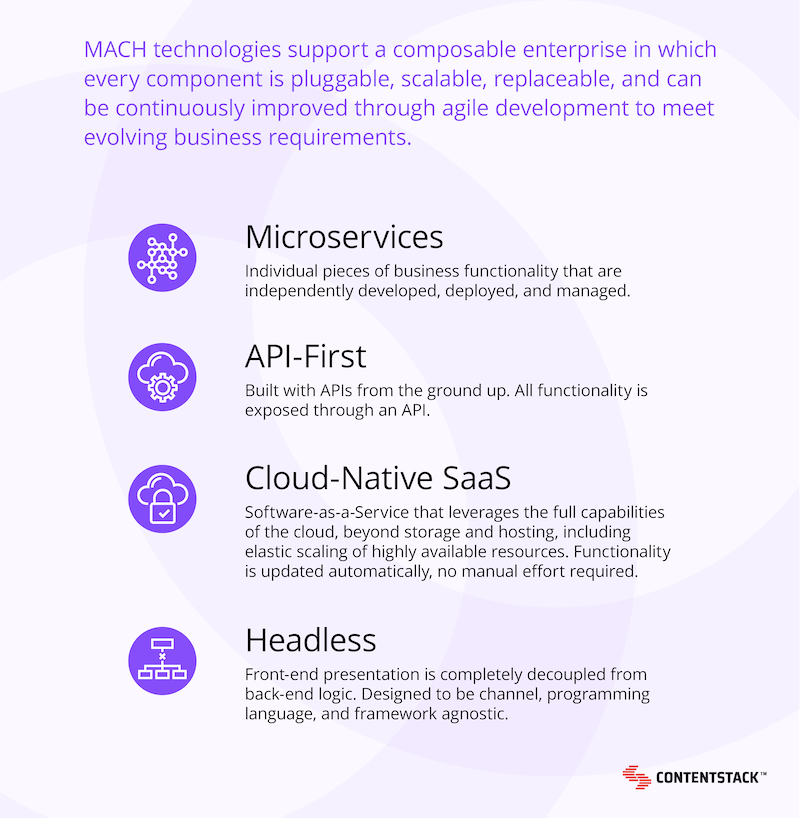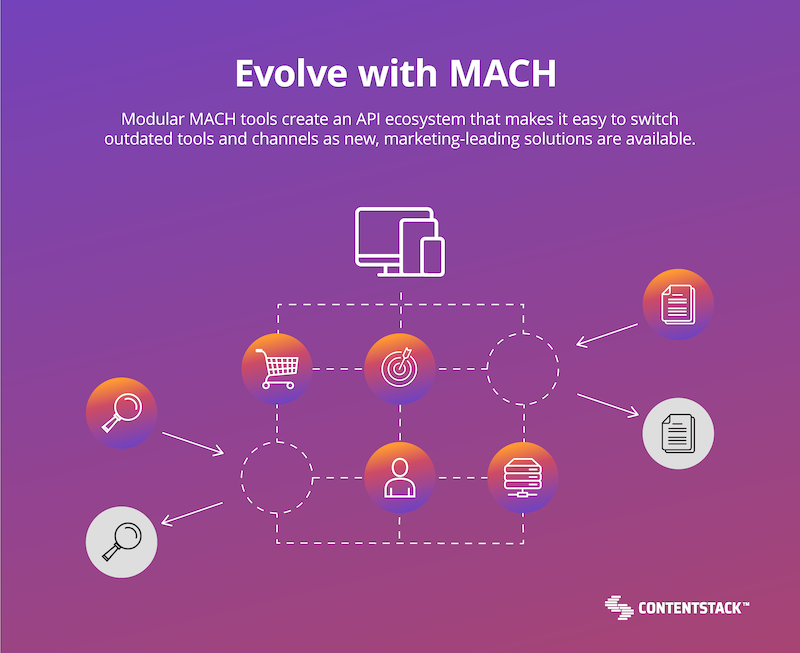
Legacy technology, systems, and tools that require outdated methods are nearly impossible to avoid. Digital business is evolving so quickly that a technology purchased just a few years ago might already be considered “legacy.” It’s no surprise that 64% of IT leaders say a top factor in their budget is a need to upgrade outdated infrastructure.
Legacy tools are not just frustrating to work with, they slow business down. In a 2019 survey, two-thirds of developers said that maintenance of a legacy system and technical debt hinder improved productivity. The catch-22 is that removing these legacy systems, and detangling the spider web of dependencies and customizations that have been built around them, can feel like even more effort than maintaining them.

Of course, the custom workarounds needed to keep legacy tools running also add up, making the barrier to change larger. As Tom Morgan, Director of Digital at The Spectator, put it, “In terms of ability to innovate, everything had a cost associated with it, which put us off doing anything risky. That meant our technology was stagnating — as was our ability to serve customers.”
Morgan and his team at The Spectator tackled this problem head-on by completely modernizing their architecture (full story in the newly published enterprise architecture ebook). Still, many enterprise companies need a way to embrace new tools without a significant infrastructure project.
Businesses need a way to modernize their digital experience, safely step off legacy technologies over time, and create a framework that doesn’t require a “rip-and-replace” process to evolve in the future.
The Emperor Has No APIs (but MACH Tools Do)
Luckily, businesses looking for new solutions have a good pool to choose from because enterprise software is having a hot moment right now. The rise of customer expectations, the expectations of employees familiar with modern consumer technologies, and the rapid advancements in programming and cloud computing have led to advanced software designed for the speed, scale, and flexibility needed by today’s digital business.
The need for software to help businesses grow quickly, exponentially, and in multiple ways — also known as being “future-proof” — has found its way into the messaging of many vendors. They know that if they aren’t omnichannel and integration friendly, their tool is obsolete. For some vendors, the solution was to “modernize” their existing software by wrapping it in APIs.
But merely having an API doesn’t make a solution ready for modern business. If the software still requires manual updates, only integrates with a limited selection of other tools, or has a monolithic structure behind those APIs — there’s a good chance it’s a legacy tool in disguise.
Enter MACH tools, a growing trend of software designed with the principles of microservices, API-first, cloud-native, and headless. These tools are API-first, not API-added. From the ground up, MACH technologies are built to be modular, pluggable, scalable, and support continuous development.

Thanks to their modularity, MACH tools are a solution for enterprises that need to quickly alleviate the pains of an outdated experience while gradually stepping off legacy tools.
Stop Vendor Lock-In
It makes business sense for software vendors to have their customers (you) use their product for the majority of the digital experience. The more you rely on their software, the less likely you are to replace it. Back when “digital business” meant merely having a website, this also made sense for the enterprise - one vendor and one contract to cover all your digital needs.
But as digital needs expanded and became unique to individual businesses, the “all-in-one” platform became more of a burden than a benefit.
For example, say there is a platform that is top of the line in commerce, but the content and search capabilities are subpar. If their goal is to be your “core” platform, chances are they aren’t going to make it easy to integrate with other content and search tools. Choosing the platform for its best feature means being locked into its not so great ones.
Designed with the understanding that an enterprise’s digital needs are too complex for a singular “all-in-one” platform, MACH tools support a composable enterprise, where businesses have the freedom to select, integrate, and replace any tool down to the level of individual functionality.
For instance, while Contentstack’s full-text query search can work for smaller sites, it wouldn’t be the best option for sites with thousands of content items that need dynamic search. So Contentstack recommends integrating with leading search platforms and provides guides on how to do so. We focus on delivering the best-in-class headless CMS and integrating easily with everything else.
This focus on integration helps alleviate a second way that businesses get locked in by software, when it’s not just features they are stuck with but the broader solution ecosystem.
With their more monolithic architecture, legacy tools require custom code, plug-ins, or workarounds to support new initiatives. Over time this becomes a hairball architecture, with dependencies, created one at a time, sometimes by people who don’t work at the company anymore. Trying something new feels like it might trigger a domino effect of errors across these dependencies, and untangling the ball would take too much time. Your experience is locked into what is already there because innovation feels like too much time and risk.
MACH technologies are relatively standardized. Every functionality is accessible through an API — so there are no plug-ins or workarounds needed. Additionally, their microservice design keeps functionalities tightly coupled to one another, so if there is an issue in one functionality, there is no risk of a cascade of errors. Another powerful functionality is using an event model that includes webhooks that enable intercepting events and taking custom actions. Adding new functionality, or trying new initiatives, can be done quickly with minimal risk.
Overall, this makes MACH solutions less “sticky.” Meaning you keep them in your ecosystem as long as they are still the best fit, not because they are too hard to remove.

End the Replatforming Cycle
The modularity of MACH tools means that reorganizing your solution ecosystem is less “ripping” and more “clicking.” Simply put, these tools benefit from being designed after APIs and microservices became a widespread design practice instead of having to retrofit a monolithic codebase into a modular world. MACH technologies are API-first, not API-added.
Because they are created from a foundation of microservices and exist natively in the cloud, these tools can be offered as Software-as-a-Service (SaaS). This means that you subscribe to only the resource you use and you can autoscale these resources up and down. Upgrades to the services happen automatically and continuously — no manual versioning is required. While upgrading to a new version may not be the same as replatforming, if the latest version of a software loses backward compatibility, it can require nearly as much effort.
A services model also means that you can modularly implement MACH tools. Because MACH tools are composed of individual services, you can start on any corner of the experience with any MACH tool (even with specific functionalities) and be sure that as you expand the experience those services will be compatible with future additions and changes. As-a-service products let you break away from the “stop-rebuild-restart” pattern of monolithic tools.
Step Off Gradually
While the ease of upgrading architecture once MACH tools are in place is excellent, the first replatforming pain to tackle is how to remove the current legacy system without disrupting business.
Because MACH solutions can be added service by service, businesses can start decoupling their architecture without entirely ripping out their legacy tools. Key functionalities can be up and running quickly, so teams can go ahead and start making improvements to the experience, and businesses can gradually untangle legacy dependencies one functionality at a time.
In our latest ebook, we interviewed enterprise technology directors and solution consultants who moved from monolith to MACH. They shared advice on first steps, evaluating vendors, and what they learned about transitioning to a modern architecture. If you’re curious to learn more, we recommend reading: Break the Replatform Cycle with MACH Enterprise Architecture.




